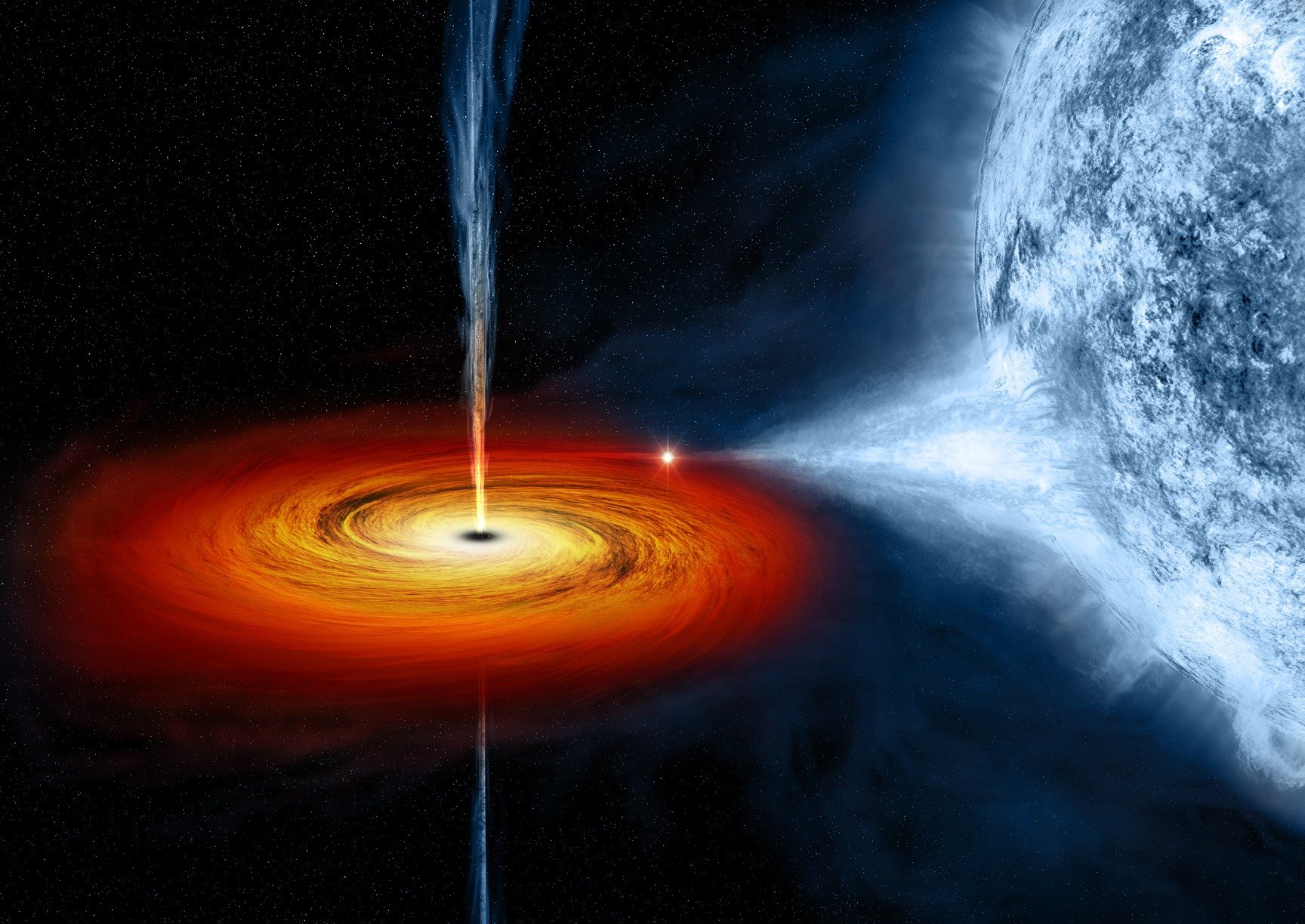Black Holes are very peculiar objects. They first came into being as mathematical abstracts (thanks, Einstein!), then became a “maybe objects“ and finally the first one was discovered in 1971. Decades later, they remain the coolest (well, not literally) and the most mysterious objects out there. After all, have you ever seen a black hole?
Stellar black hole
A “normal black hole” (though there is nothing normal about a black hole if you ask me!) or a stellar black hole is a very compact object 5-10s times heavier than the Sun. Its gravity is so strong that nothing, not even light, can escape it. Stellar black holes form when a big star runs out of fuel to burn at the end of its life and collapses onto itself (find out how stars with different masses evolve here).
Supermassive black hole
As if that was not enough, astronomers tell us that there are such things as supermassive black holes (or SBHs), monstrosities that can be billions times heavier than our Sun. Scientists think that nearly all big galaxies have SBHs at their centres. There is one at the centre of our Milky Way galaxy too! The object residing in our galactic core, called “Sagittarius A”, is as heavy as 4 million Suns and is smaller than the Solar System.
Supermassive black holes are too big to be born the same way as the stellar black holes. Scientists are not sure about the exact mechanism of their formation, but they have lots of hypotheses! Prof Mitch Begelman of the University of Colorado is a SBHs expert. He says that there are two likely ways these giants form. Very big stellar black holes can grow into SBHs by sucking in the surrounding gas (or even merging with other black holes). Alternatively, SBH may be born when a huge gas cloud in a young galaxy collapses to form a supermassive unstable star. That star later collapses into a SBH, skipping the supernova explosion (and therefore saving all the material).
Intermediate-mass black hole
Ok, there are small black holes, there are huge black holes. Anything in between? Maybe!
The intermediate-mass black holes with masses between 100 and a million solar masses are hypothetical objects. Even though some astronomers claim they have observed them, the existence of the intermediate-mass black holes is not 100% confirmed.
Primordial black hole
Are you still following? There is another exotic hypothetical kind of black holes, called primordial black holes. Just as the name suggests, these black holes could have formed seconds after the Big Bang as a result of gravitational collapse of “lumps of matter”. As they are not made of star seeds, there is no limit to how big or small they have to be! In theory, they can be of any size. Although the tiniest ones have probably evaporated by now via the process called Hawking radiation. If exist, they contribute to the mysterious dark matter.
Anatomy of a black hole

Black holes are surprisingly simple objects. The simplest model of a black hole is a non-rotating black hole or Schwarzschild black hole.
Here we have a singularity, the point at the centre where all the mass is concentrated. Surrounding the singularity is a spherical event horizon. The light emitted within the event horizon will never escape a black hole since the escape velocity will be greater than the speed of light. The size of the event horizon is determined by Schwarzschild radius.
In reality though, black holes probably do spin (Kerr black hole). Rotation changes the shape of both singularity and event horizon, turning singularity into a doughnut (with zero thickness) and the event horizon into a squashed sphere.
All the properties of a static black hole (for the external observer) are determined by ONLY its mass and by mass AND spin for rotating black hole. How simple is that? Ok, to make it extra realistic and super complicated you can throw in one more parameter – charge. But that’s it! The rest doesn’t matter, they say a black hole “forgets what goes inside”. Scary!
Observations of black holes
How can you see something that doesn’t shine? By looking at how it affects the surrounding matter!
Accretion
- If there is a gas, dust or even another star in a black hole’s neighbourhood, it can be “sucked” into the black hole. Instead of falling straight in, the material will form an accretion disk of swirling matter around the event horizon. The material accelerates and warms up! We can see it!
Gravitational pull
- See a star that wobbles on its orbit? Or a group of stars orbiting around a small dark area? You might have just spotted a black hole!
Gravitational lensing
- We usually talk about gravitational lensing when we discuss exoplanets as it is a great method to look for alien worlds. But it can also help us find a black hole or two. If there is a black hole between the shiny object and an observer, the black hole’s gravity will bend the light coming from an object. So the observer will see not one, but two images of the object! Sounds pretty cool!
Jets
- Black holes, especially SBHs, sometimes burp our an ionized material as they feed. We can observe these events as powerful jets flowing along the rotational axis of the black hole
Direct image
- All the methods are great, but is it possible to “see” the black hole itself? This is exactly what the project called Event Horizon Telescope is trying to do right now! Its aim is to get the first ever direct image of a supermassive black hole in the centre of the Milky Way. To spot something that’s so far away, you need a telescope as big as Earth. We cannot possibly build a dish that big, but we can use a technique called “long baseline interferometry”, when you observe an object with a few different telescope placed some distance apart and then combine the images. Event Horizon is a VERY long baseline interferometer that consists of nine radio telescopes! Astronomers completed the observations last year. Now they are working hard to put those images together! Maybe we are about to see a supermassive black hole’s silhouette.
Still curious?
Go to Chandra X-Ray observatory web-site to learn more about black holes.
Go to our space dome web-site to learn about space or to book your portable planetarium visit.

